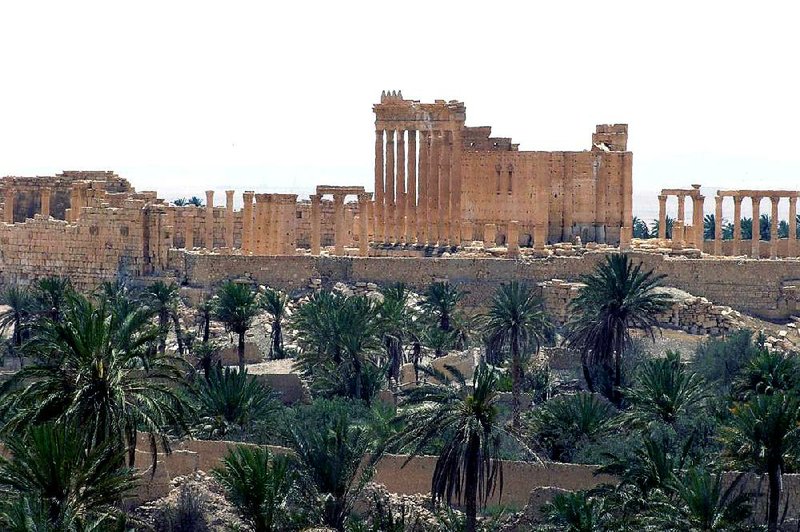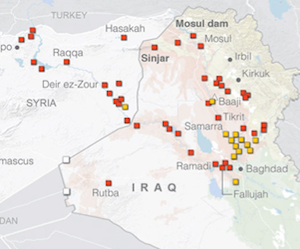DAMASCUS, Syria -- Islamic State militants overran the famed archaeological site at Palmyra early Thursday, just hours after seizing the central Syrian town, activists and officials said, raising concerns the extremists might destroy some of the priceless ruins as they have done in neighboring Iraq.
The takeover also expanded the extremists' hold, making them the single group controlling the most territory in Syria.
Militants also captured Palmyra's airport and Tadmur prison, delivering a new defeat for President Bashar Assad, whose forces quickly retreated. Hundreds of Palmyra residents fled the town of 65,000, and many more were trying to escape, said Talal Barazi, the governor of central Homs province, which includes Palmyra.
Palmyra is a strategic crossroads linking the capital, Damascus, and cities to the east and the west. Its capture raised alarm over some of the world's most important ancient ruins, whose fate remained unknown Thursday, and no photos or video emerged from the militants.
"We are in a state of anticipation and fear," said Maamoun Abdulkarim, the head of the Antiquities and Museum Department in Damascus. "The city is now totally controlled by gunmen, and its destiny is dark and dim."
A UNESCO world heritage site, Palmyra boasts 2,000-year-old towering Roman-era colonnades, temples and priceless artifacts.
They are the remnants of an Arab client state of the Roman Empire that briefly rebelled and carved out its own kingdom in the third century, led by Queen Zenobia, with Palmyra as its capital. Before the war, it was Syria's top tourist attraction, drawing tens of thousands of visitors each year.
With the capture of Palmyra, the Islamic State militants now control half of Syria and most of the country's oil wells, according to the Syrian Observatory for Human Rights, making it the group with the most territory under its authority among the myriad factions fighting in the country's civil war.
Its terrain inside Syria stretches from the group's westernmost strongholds in Aleppo province to its core territory in northeastern Syria down to central Syria, with footholds in Damascus.
The militants' capture of Palmyra came just days after the fighters seized the strategic Iraqi city of Ramadi, illustrating the extremists' ability to advance on multiple fronts at opposite ends of a battlefield that spans the two countries, where the group has declared a caliphate, or Islamic state, on the territory it controls.
At the White House, spokesman Josh Earnest described the developments in Palmyra and Ramadi as setbacks, but insisted the U.S.-led air campaign was making progress overall "in degrading ISIL capabilities," using an alternate acronym for the group.
The head of the U.N.'s cultural agency called on Syria's warring factions to immediately end hostilities around the archaeological site.
"I am extremely worried about what happens in Palmyra," UNESCO chief Irina Bokova said. "Palmyra is an extraordinary world heritage site in the desert and any destruction to Palmyra is not just a war crime, but ... an enormous loss to humanity."
In taking Palmyra, the Islamic State also seized control of the Tadmur prison, freeing some of the inmates, said Bebars al-Talawy, a Homs activist. The government had already transferred thousands of detainees from the prison to a jail near Damascus as the Islamic State attacked the city, al-Talawy said. Thousands were believed to still be inside, he said, but he couldn't provide precise figures.
The prison survives in the collective memory of Syrians as the place where dissidents were held for decades and prisoners tortured.
The Syrian Observatory for Human Rights said Thursday that according to its estimates, 462 people have been killed since the Islamic State began its offensive on Palmyra and nearby areas May 13. It said the dead included 241 troops and pro-government gunmen, as well as 150 Islamic States fighters. The rest were civilians.
Meanwhile, militants made further inroads in Iraq's Anbar province, seizing the Iraqi side of a key border crossing with Syria after Iraqi government forces pulled out, according to Athal al-Fahdawi, a local councilman. The fall of the al-Walid crossing will help the militants to shuttle weapons and reinforcements more easily across the Iraqi-Syrian borders.
Despite the Islamic State's victories in Palmyra and Iraq, the extremists suffered a setback in Syria's northeastern province of Hassakeh, where they have come under attack by Kurdish fighters.
The Kurdish fighters captured much of the Abdul-Aziz Mountain near the village of Tel Tamr on Wednesday, according to the Syrian Observatory for Human Rights and the Kurdish forces known as the People's Protection Units.
The activist group said Kurdish fighters were backed by airstrikes of the U.S.-led coalition, which has been bombing Islamic State positions in Syria since September.
Information for this article was contributed by Bassem Mroue and Sameer Yacoub of The Associated Press.
A Section on 05/22/2015

